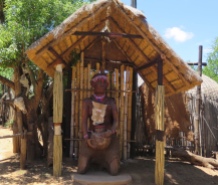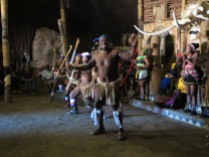Sunday, January 14, 2018
We docked this morning in Richards Bay, South Africa, and had signed up for an excursion to Shakaland Cultural Village. It’s part of a set for the mini-series, “Shaka Zulu,” which was filmed in the mid-1980’s. Shaka kaSenzangakhona, or Shaka Zulu was a strong leader who united several African tribes under his rule. As a warrior, he changed the method of battle from only using spears from a distance to also using daggers for close combat.
On the drive to Shakaland our guide tried to teach us a few words in Zulu. I think I can remember one – yay bo – which means yes. The Zulu language uses lots of clicks so it’s impossible for us to actually pronounce many of their names and words. Our guide’s name was Tomsana (or something like that.) He explained that a person’s name is based on what happens on the day of your birth, maybe a reflection of the weather or of your parents’ relationship or how they were feeling on that day. You don’t want to be born on a day when your parents are fighting with each other.
In the Zulu culture, you can have as many wives as you want, that is, if you can pay the dowry, which is eleven cows. The first cow is for the girl’s father, so it must be the biggest and best; the second is for the girl’s mother, and is the second best; the third for the girl’s virginity, and is the third best. The other eight cows can be smaller than the first three. A good cow is worth $800-$1,000.
There is a lot of sugar cane grown here. When this area was being developed by Portugal, the Zulus would not work for hire, so the Portuguese brought in Indians to work the sugar cane. Over the years, the government instituted a tax on cows which could only be paid in cash. That proved to be an incentive for the Zulus to work for hire in the urban areas. Unfortunately, as a man earned more money, he could afford more wives and have more children, and the growing population of Zulus was seen as a threat to the British, who had defeated the Portuguese for control of South Africa.
When we arrived at Shakaland, we were greeted by “villagers” in Zulu attire. They guided us into the site and offered some beverages, much appreciated on this hot day (about 90 degrees.)
While we were waiting for the tour, I saw several colorful insects flying around. I noticed one person run I looked it up – he was correct. It’s a CMR Bean Beetle, a variety of blister beetle. A blister beetle has a defensive secretion called cantharidin, a poisonous chemical that causes blistering of the skin, and is used to remove warts. The beetle was given the name “CMR” because its colors were the same as that used by the Cape Mounted Riflemen of the 1800’s.
We first needed to get permission to enter the village from the chief. We were treated to demonstrations of leather processing, wood carving, beer production, spear throwing, and more. There were shopping opportunities here, of course.
An unmarried Zulu woman wears a short skirt. When she marries, she wears a long skirt and a red hat that she never takes off. To take it off is the same as getting a divorce. Even when sleeping, she wears this hat, and we got to see the wooden “pillow” that a married woman would use to keep her head up.
Following this, we enjoyed a singing and dancing demonstration. There are several styles of Zulu dance, the most dramatic of which includes high kicks and foot stomps, and occasionally falling backward to the ground, landing on the rear end.
Lunch, then a bus ride back to the ship just in time to meet with customs people as we departed South Africa.




















